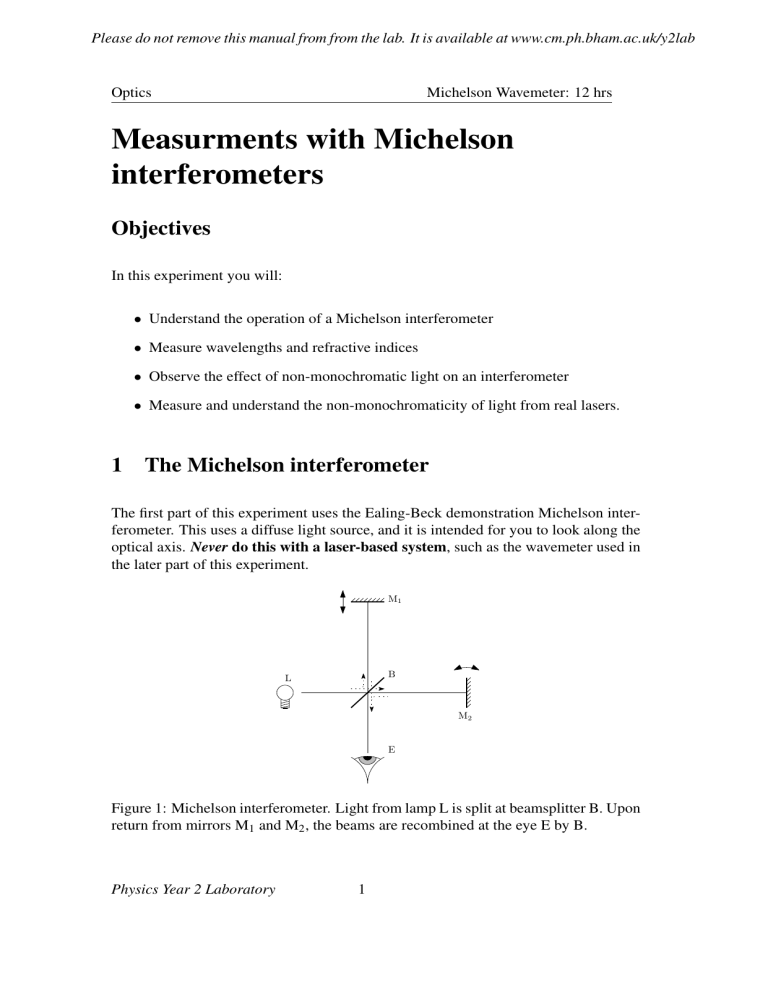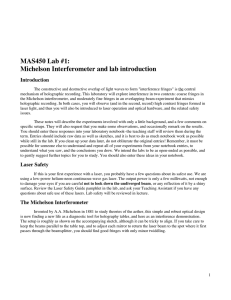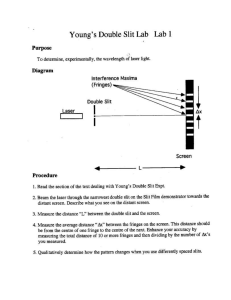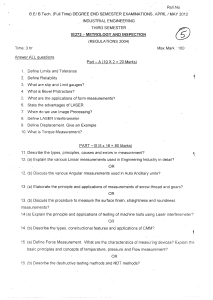
Please do not remove this manual from from the lab. It is available at www.cm.ph.bham.ac.uk/y2lab Optics Michelson Wavemeter: 12 hrs Measurments with Michelson interferometers Objectives In this experiment you will: • Understand the operation of a Michelson interferometer • Measure wavelengths and refractive indices • Observe the effect of non-monochromatic light on an interferometer • Measure and understand the non-monochromaticity of light from real lasers. 1 The Michelson interferometer The first part of this experiment uses the Ealing-Beck demonstration Michelson interferometer. This uses a diffuse light source, and it is intended for you to look along the optical axis. Never do this with a laser-based system, such as the wavemeter used in the later part of this experiment. M1 B L M2 E Figure 1: Michelson interferometer. Light from lamp L is split at beamsplitter B. Upon return from mirrors M1 and M2 , the beams are recombined at the eye E by B. Physics Year 2 Laboratory 1 Optics 1.1 Michelson Wavemeter: 12 hrs Principle of the Interferometer The Michelson interferometer splits one beam of light into two by partial reflection at a beamsplitter. The two beams travel along separate paths, each is reflected by a mirror, and they are recombined by the beamsplitter, see Figure 1. Whether the recombination results in constructive, destructive, or partial interference is determined by the precise path lengths, which are independently adjustable by moving the mirrors. Compare your interferometer with the idealised picture,and explain any differences. Q We can analyse the interference pattern by unfolding the reflections at the beamsplitter and considering the virtual images of a point P on the extended source L that are formed by the two mirrors, see Figure 2. Show that the path difference between rays from P0 and P00 to the eye is 2d cos θ . These rays will interfere constructively whenever this is an integer number of wavelengths: Q 2d cos θ = nλ . Hence explain why the expected fringe pattern is a set of concentric circles (“fringes of equal inclination”).1 Write down answers to the following questions, which will help with the setting up procedure below: How does the diameter of a given fringe vary as d gets smaller? How does the spacing between fringes vary? L1 L P M1 M2 P ′ L2 P′′ θ d Figure 2: Formation of fringes. M1 and M2 are the effective positions of the mirrors, L1 and L2 are the images of source L as seen in the mirrors. 1.2 Setting up the interferometer Using a monochromatic (single wavelength) source, carefully adjust the interferometer until you can see and control the circular fringes. A mercury lamp followed by a filter that passes just the green spectral line of mercury is suitable. Note that two conditions need to be met for good alignment: (i) the mirrors must be “parallel” in the sense of figure 2 and (ii) d must be small enough that your eye can resolve the angular 1 We are ignoring any phase changes at the mirror and beamsplitter surfaces. These may shift the central maximum away from d = 0, but will not affect the variation with θ or d. Physics Year 2 Laboratory 2 Optics Michelson Wavemeter: 12 hrs difference between succesive rings. First adjust the parallelism using the screws on M2 to make the images of the source overlap as precisely as possible. Then use the micrometer drive to translate M1 until d is zero. You will probably need to make very small adjustments to the tilt of M2 to keep the pattern centered. Eventually a single fringe should fill the field of view. Record your observations as you proceed. 1.3 Wavelength measurement Use the micrometer that drives mirror M1 to make an approximate wavelength measurement. Move M1 slowly, while counting fringes as they appear (at θ = 0) and recording the start and end readings of the micrometer. Note that the motion of the mirror is reduced by 5 times by the action of a lever between the micrometer and the mirror. Use the formula 2d cos θ = nλ to determine the measured wavelength. Compare with the recognised value of 546.074 nm for the bright mercury green line. 1.4 White light fringes Each wavelength that is put into the interferometer will produce a set of circular fringes having a different spacing. If several wavelengths are present at once, their fringes will be superposed. White light contains a wide range of wavelengths, and the net effect of the superposition is that no fringes are visible, with one exception: the n = 0 fringe will be in the same place for every wavelength, so by setting d = 0 , one or two fringes can be seen with white light. Using a white light source, set up the interferometer to find the white light fringes. It can be helpful to tilt M2 very slightly, so its effective position (in Figure 2) crosses that of M1 . Then translate M1 slowly, watching for a few fringes to move across the field of view. It helps to start off close to d = 0. Record the appearance of the white light fringes, and explain their coloured edges. But keep the Hg lamp on: useful for re-finding d=0 Without the filter, the mercury lamp appears a bluish white. Why is it a poor “white light” for this purpose? Q 1.5 Perturbations of the optical path Investigate the effect of introducing e.g. warm air rising from your hand, compressed “air” from a can, or a thin mica sheet2 into one of the optical paths. Explain your observations. 2 Mica is a natural transparent mineral that cleaves into atomically-defined sheets Physics Year 2 Laboratory 3 Optics 1.6 Michelson Wavemeter: 12 hrs Refractive index of glass Introducing a glass plate of thickness t and refractive index n in one arm of the interferometer will increase its optical path length by 2(n − 1)t. The white light fringes will therefore vanish, but you can find them again by adjusting the micrometer by 5(n − 1)t (the 5 comes from the lever). Explain this formula, and use this method to find the refractive index of the glass disc provided. It helps to estimate where the fringes will be found; you could guess n = 1.5 to begin with. The fringes will be harder to see, and you may have to revert to the mercury lamp to start with. Why are the fringes of lesser quality with the glass present? Physics Year 2 Laboratory 4 Optics 2 Michelson Wavemeter: 12 hrs The Michelson Wavemeter This part of the experiment uses a Michelson interferometer that has been custom built using standard optical components. Its main light source is a red He/Ne gas laser; a second laser can also be introduced. The laser powers are nominally 1 mW. What laser safety classification does this correspond to? Do not look along the beams, and avoid Q causing reflections (e.g. from jewellery) while adjusting the system. 2.1 The principle of the instrument Turn on just the HeNe laser, work out the optical paths, and draw a diagram of the system. The principle is the same as that of the interferometer in Figure 1, except that the moving mirror is double sided, so both path lengths change at once, and d changes four times as much as the mirror carriage is moved. The moving mirrors are actually corner cube retroreflectors - why is this helpful? The other mirrors just steer the beams around the optical breadboard. The laser beams travel parallel to the optical axis of the system (θ = 0 everywhere), and they meet on a photodiode detector. Their alternate constructive and destructive interference can be seen on the oscilloscope as the carriage is carefully moved by pushing it with a finger. The oscilloscope also shows a digitised version of the same signal. A further channel of the oscilloscope is connected to an optical switch (light gate) that moves with the carriage. This provides a logic signal that is high only while the carriage is moving over a length standard. The wavemeter works by automatically counting the number of fringes that pass by, as this length is traversed. 2.2 Wavelength of the HeNe laser First, practice getting a good set of fringes on the oscilloscope as you move the carriage smoothly from one end of its range to the other. Ideally, there should be no variation in the photodiode output except from this motion. In practice, you will find that vibrations of the bench or breadboard cause fringe shifts as well. Experiment to find out how gentle you need to be. Why does resting a finger on the breadboard cause fringes to move? What is the connection with the LIGO experiment to detect gravity waves? It Q is interesting to expand the beam by placing a lens near the laser output, and compare the fringe pattern with that seen in the earlier part of this experiment. The fringe counter counts every pulse of the digitised detector signal during the time that the optical switch is blocked by the length standard. For reliable counting, the Physics Year 2 Laboratory 5 Optics Michelson Wavemeter: 12 hrs threshold level must be set above the noise, but below the height of all the fringes. This can be judged from the scope screen, and by the consistency of the results. It may be that the fringe height is not uniform over the whole of the calibrated length. This can be for one of two reasons: (i) the beams are slightly misaligned so they drift off the photodiode as the carriage moves, or (ii) the laser is producing multiple wavelengths, and you are seing beats within a superposition of interference patterns. To cure (i), consult a demonstrator for help in making a tiny adjustment to the mirrors. The cure for (ii) depends on the laser. All light sources have a coherence length, a maximum difference in optical paths over which an interfence pattern will form. The less monochromatic the light, the shorter the coherence length (you saw this with the white light fringes). If the laser has just a couple of active longitudinal modes, just waiting a few minutes may help: as the laser warms up, the mixture of modes at its output varies - why? You can coax it to change with a bit of thermal insulation. Alternatively, you may have to use a shorter length standard, placed where the interference is strong. Take several counts of the interference fringes, while monitoring the scope to check that the fringes are of good quality. Using the length of the length standard, calculate your best value for the HeNe wavelength. Compare with the nominal value of 632.816 nm (in air). Comment on the important sources of error. 2.3 Wavelength of a second laser In fact, the wavelength of a HeNe laser is known to standards-lab accuracy, and the normal use of a wavemeter is to compare an unknown wavelength with that of the HeNe. Place the green solid-state laser so that its beam follows excatly the same path that the HeNe did. Using the oscilloscope, try to get good fringes from the solid state laser, and measure its wavelength. You may need a shorter length standard if the coherence length is short. The length standard need not be accurately measured, because you can eliminate it from your measurements. 2.4 Multiple modes of a laser If the wavemeter output looks like Figure 3, two (or more) laser modes of different wavelength are present with about equal intensity, and the beat pattern is produced by superposition of their respective interference patterns. By using the signal from the length standard you can estimate the spatial extent of the lobe, x (remember this is not the same as the mirror displacement). Distance x corresponds to n1 cycles of the Physics Year 2 Laboratory 6 Leave the HeNe laser switched on: it takes a while to stabilise Optics Michelson Wavemeter: 12 hrs Figure 3: Wavemeter output with two wavelengths present mode having wavelength λ1 , but n2 cycles of λ2 , where (n2 − n1 ) = 1. It is easily shown that λ1 − λ2 = λ 2 /x, where λ is the (geometric) mean wavelength. Calculate ∆λ = λ1 − λ2 for your laser. Why is it still a good approximation to think of a laser as monochromatic? What is the connection between the mode spacing of the lasers, and the length of the laser cavity? 2.5 Refractive index of air Place the glass cell in one of the interferometer arms, and use the scope to count fringes as you change the air pressure in the cell using the hand pump. Using this method, you can easily measure (n − 1) for air, even though n is only 1.000x. (The cell is 100.0 or 50.0 mm long) MSC 2015-09-25 Physics Year 2 Laboratory 7


